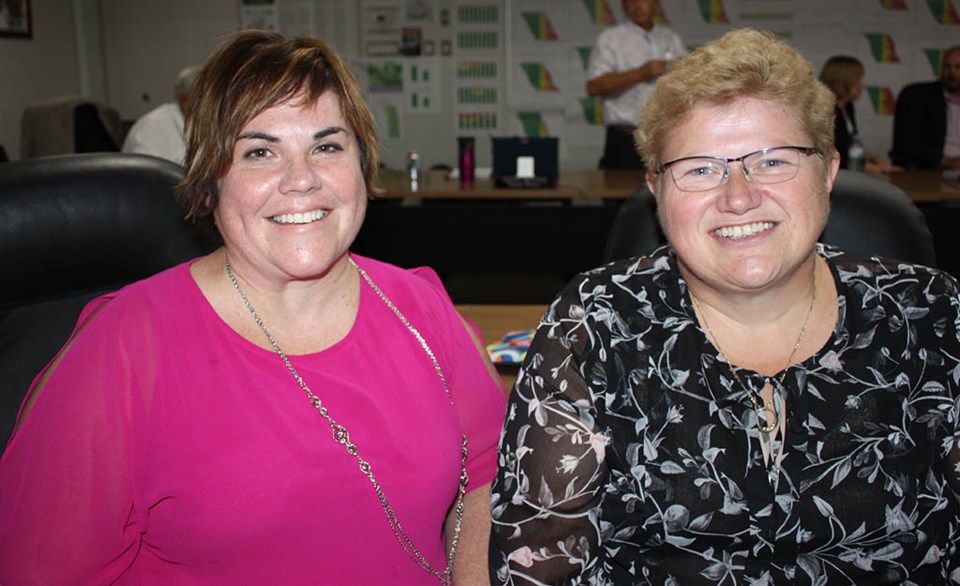A two-part presentation regarding student-learning opportunities caught the attention of the board members attending the Sept. 12 meeting of the South East Cornerstone Public School Division.
The information was brought to the boardroom by educators/administrators Jeff St. Onge and Sherrie Meredith, representing McNaughton School in Moosomin, who opened the presentation and were then followed by Nancy Fraser and Devona Putland from Redvers School.
Lynn Little, the director of education for the division, filled in the background information regarding the division’s goals and the support staff members who augment the processes that are brought forward for these programs.
St. Onge said the opportunities for students grow from the factors such as teacher skills and flexibility, that allows student interest to flourish.
It was pointed out how Meredith built partner teaching teams while the division gave the school consistency within the administration. This gave the educators and students new learning parameters to explore. Those additional talents were on display during the presentation as examples of computer science, photography and media platforms were put on display along with advancements in an agriculture 30 course.
Some students in the English as another language courses were able to schedule classes together for some units of study, allowing teachers to work more efficiently, St. Onge noted.
“Differentiation was seen in instruction delivery and in assignments,” said St. Onge.
Instructors ensured students weren’t doing the same things repeatedly, but rather working on a variety of challenges in areas such as vocational courses which brought forth talents in such things as carpentry, mechanics, welding, design, fine arts and computer science, including website and network design, sign making, robotics, video production and communication.
These classes were carefully monitored and guided and “the path is student driven,” St. Onge said. “It allows for individualized programs and sometimes it results in one teacher and one student, or one teacher and two or three students.”
The work is made easier as student leaders emerge from the process to help drive the projects forward and within a proper timeline.
“The teacher provides the knowledge, guidance and oversight.”
Meredith provides most of the planning and scheduling, and that makes for even more conversations with the students, he said.
“Discussions lead to decisions and the route to take, what they plan to do and how long they will take to do it,” said St. Onge, who is principal at McNaughton.
The two provided some photographs and videos that clearly illustrated the progress and interest shown by students engaged in various projects that included rebuilding a truck engine, doing videos or building various one-off pieces of equipment with valuable uses.
Meredith teaches portfolio development along with evaluations and assessment organization while developing contracts with the students, with outcome connections and an exit interview, “so they know the expectations and what they should be looking for in the process,” Meredith said.
The students at McNaughton learn to show their progressive steps along the way, and chart their progress. As an example, she displayed an artist’s statement following the completion of an extensive visual fine arts project.
The exit process is also important “because they leave a gift for me that I can use to motivate the next one,” she said. “The students get a voice around the school and that is empowering for them, and, of course, some projects don’t get done but there are credits to be gained for those who see successful conclusions.”
In the second part of the presentation, Fraser and Putland focused their attention on the early learners in their Kindergarten - Grade 12 school that houses over 300 students.
“We see all avenues of training including three tiers of intervention, for instance,” said Fraser who noted that early learning readers “learn to read from kindergarten to Grade 2 and then read to learn from Grade 3 on. The journey with literacy is always our focus.”
“It’s best practice and common sense, so you can’t really go wrong,” added Putland.
The students who benefit from literacy intervention, were generally selected by classroom teachers. Programs were individualized to school needs. MacLeod targeted 22 Grade 3 students, while Redvers targeted a variety of students between Grades 1 and 4.
“The concept is to improve readiness and build an interest in reading while also building confidence,” said Fraser.
Putland said six weeks of half-day splits between Redvers and MacLeod School in Moosomin gave her an opportunity to work with classroom teachers. There was explicit instruction offered for vocabulary, phonics, and comprehension. Practising fluency and building motivation and engagement were all part of the plan.
“We want to tap into their interests and we can do that with poems, jokes or riddles,” said Putland, who added that some items such as jokes or riddles can be difficult for English as another language students, so the teachers and consultants are well aware of that situation.
Word ladders are built and vocabulary lists are made from high frequency phrases, they explained.
Putland and Fraser also spoke about internet resources they helped parents get adjusted to so their children would be less likely to suffer from the annual “summer slide,” meaning that some students lose a few learning skills or forget certain items during the lengthy summer vacation break.
“Reading leads to writing with confidence and fluency grows from that in the younger participants,” said Putland.
The presenters were thanked by vice-chairwoman Carol Flynn who was directing the meeting since chairwoman Audrey Trombley was unable to attend the session, but joined it via an audio connection for most of the afternoon session.



